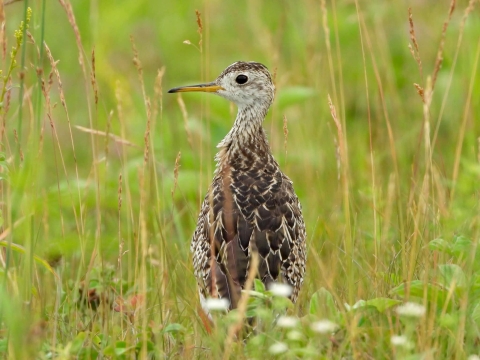What We Do
Wildlife conservation is at the heart of the National Wildlife Refuge System. It drives everything on U.S. Fish and Wildlife Service lands and waters managed within the Refuge System, from the purposes for which a national wildlife refuge national wildlife refuge
A national wildlife refuge is typically a contiguous area of land and water managed by the U.S. Fish and Wildlife Service for the conservation and, where appropriate, restoration of fish, wildlife and plant resources and their habitats for the benefit of present and future generations of Americans.
Learn more about national wildlife refuge is established, to the recreational activities offered, to the resource management tools used. Using , the staff that work on national wildlife refuges manages Service lands and waters to help ensure the survival of native wildlife species.
Management of Fort Niobrara Refuge focuses on conserving native birds, bison, and the biological diversity of the area. To help plants and wildlife, Refuge staff use a variety of habitat management tools to maintain, recover or enhance plant and wildlife values. Some tools include scientific monitoring of habitats and wildlife, bison grazing, prescribed fire, and periods of "rest", or non-disturbance. Information obtained is used to make decisions to maintain and improve habitat conditions to provide for the diverse array of plants and animals that live on the Refuge and surrounding area.
Management and Conservation
Resource Management
Refuges deploy a host of scientifically sound management tools to address biological challenges. These tools span from active water management to wilderness character monitoring, all aimed at ensuring a balanced conservation approach to benefit both wildlife and people. At this field station, our conservation toolbox includes:
- Comprehensive Conservation Plan
- Compatibility Determinations
- Cultural Resources
- Education and Outreach
- Fire Management
- Habitat Restoration
- Human Dimensions
- Invasive Species
- Inventory and Monitoring
- Law Enforcement
- Recreation Management
- Species Research
- Water Management
- Wildlife Health
Our Projects and Research
Research
Inventory and monitoring projects are done to help further Refuge purposes; inform management of biological diversity and environmental health; and federally threatened and endangered species.
Surveys or research done by Refuge staff or partners in recent years include:
- Inventory and mapping of native plant communities
- Condition and health of native grasslands as measured by plant composition and structure
- Invasive plant distribution and abundance
- Prairie grouse abundance
- Breeding bird species occurrence and abundance
- Bison health and abundance
- Bison genetics
- Elk health, abundance, and movements
- Mountain lion distribution and abundance
- Northern long-eared bat winter hibernacula
- White-nose syndrome surveillance in bats
- Bat species composition and abundance (NAbat)
- American burying beetle distribution and abundance
- Streamflow and water quality of the Niobrara River and tributary streams
- Wilderness character
Law Enforcement
Federal Wildlife Officers play a critical role in protecting wildlife and habitat as well as the visiting public.
The Mission of the Office of Law Enforcement "is to protect wildlife and plant resources. Through the effective enforcement of Federal laws, we contribute to Fish and Wildlife Service efforts to recover endangered species, conserve migratory birds, preserve wildlife habitat, safeguard fisheries, combat invasive species invasive species
An invasive species is any plant or animal that has spread or been introduced into a new area where they are, or could, cause harm to the environment, economy, or human, animal, or plant health. Their unwelcome presence can destroy ecosystems and cost millions of dollars.
Learn more about invasive species , and promote international wildlife conservation."

